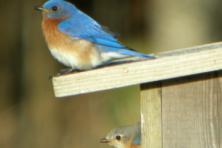Migrating Dinosaurs and DDT
- Share
- Tweet
- Pin
- Share
• Although the coast of California is very likely to experience a major earthquake within the next hundred years, the second most earthquake-prone part of the lower U.S. is closer to home. It’s the New Madrid Seismic Zone that extends from eastern Arkansas up through eastern Missouri to southern Illinois. U.S. Geological Survey scientists estimate that the chances of a magnitude 6 or larger quake occurring in this zone in any 50-year time period are between 28 and 40 percent. An eyewitness of a New Madrid quake of 1816 said that the initial violent shock “…was followed in a few minutes by the complete saturation of the atmosphere, with sulphurous vapor, causing total darkness.” (Science News, Dec. 3, 2011)
• Herds of a huge, long-necked dinosaur, called Camarasaurus, lived about 150 million years ago in what is now Utah and Wyoming. These giant plant eaters needed to consume about 1,000 pounds of vegetation each day to survive. As the seasons changed they migrated hundreds of miles, between lowland basins and more plant-rich highlands. If they hadn’t moved, it’s likely they would have decimated the vegetation in the lowlands and starved. Geochemist Henry Fricke and his research group at Colorado College determined the ratio of two oxygen radioisotopes at different levels (from the base to the tip) in the teeth of these dinosaurs. They also examined isotope ratios in sediments of lowland and highland habitats, and they discovered that the ratio is slightly different between the habitats. Analysis of a dinosaur tooth showed that isotope ratio varied along its length, and the ratios alternated between the lowland ratio and the highland ratio. This, along with other evidence, was interpreted as showing that the animals migrated several hundred miles between the two habitats on a seasonal basis. (The Week, Nov. 18, 2011; http://www.nature.com, Oct. 26, 2011)
• The use of DDT in the 1940s caused the peregrine falcon to become almost extinct in the U.S., and they vanished completely from the eastern part of the country. After poisonous DDT was banned, dedicated ornithologists at Cornell University and elsewhere took the lead in establishing breeding programs with captive birds. Their offspring were then released into the wild, and today it is estimated that the number of breeding pairs of peregrine falcons in the U.S. and Canada exceeds 4,000. Once again it is possible to see these voracious and highly skilled raptors gracing our skies. (Science News, Nov. 19, 2011)
• After 19 years in a persistent vegetative state, 39-year-old Terry Wallis of Arkansas began to talk. Scans of his brain indicated that nerve cells were establishing new connections. Thanks to brain scanning technology, neuroscientists are reevaluating what really goes on in the heads of patients deemed comatose or vegetative. The phrase “minimally conscious” is being used to distinguish between comatose patients with massive brain damage and those who retain some brain function. Those in the latter group can show improvement given enough time. However, in some of these cases, although the patient’s conscious network persists, so much damage has been done to the brain that paralysis results and the patient can only control eye movement. An example is the journalist Jean-Dominique Bauby. He recently wrote a book (The Diving Bell and the Butterfly), which was “dictated” only by blinking. The book became a bestseller. (The Week, Dec. 2, 2011; Time Magazine, Nov. 28, 2011)


